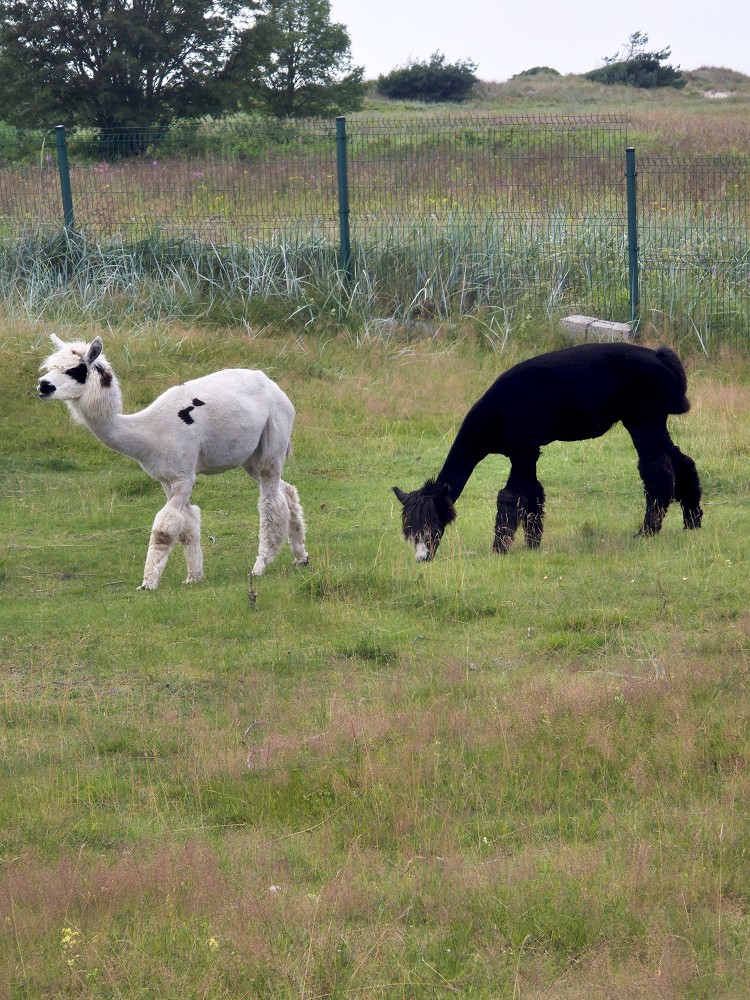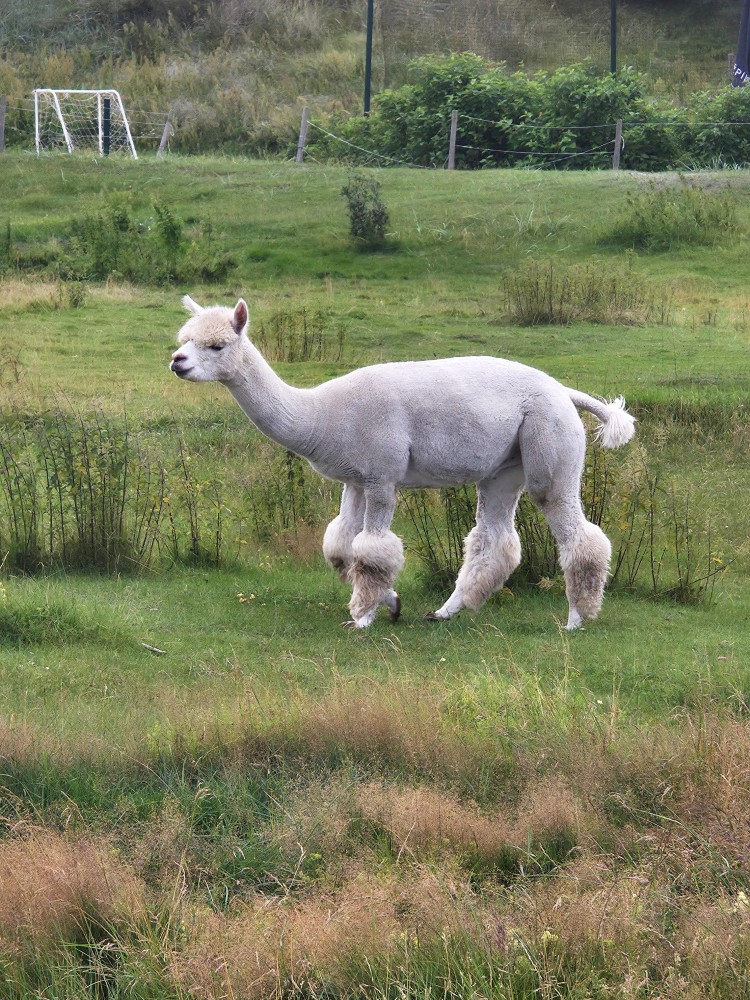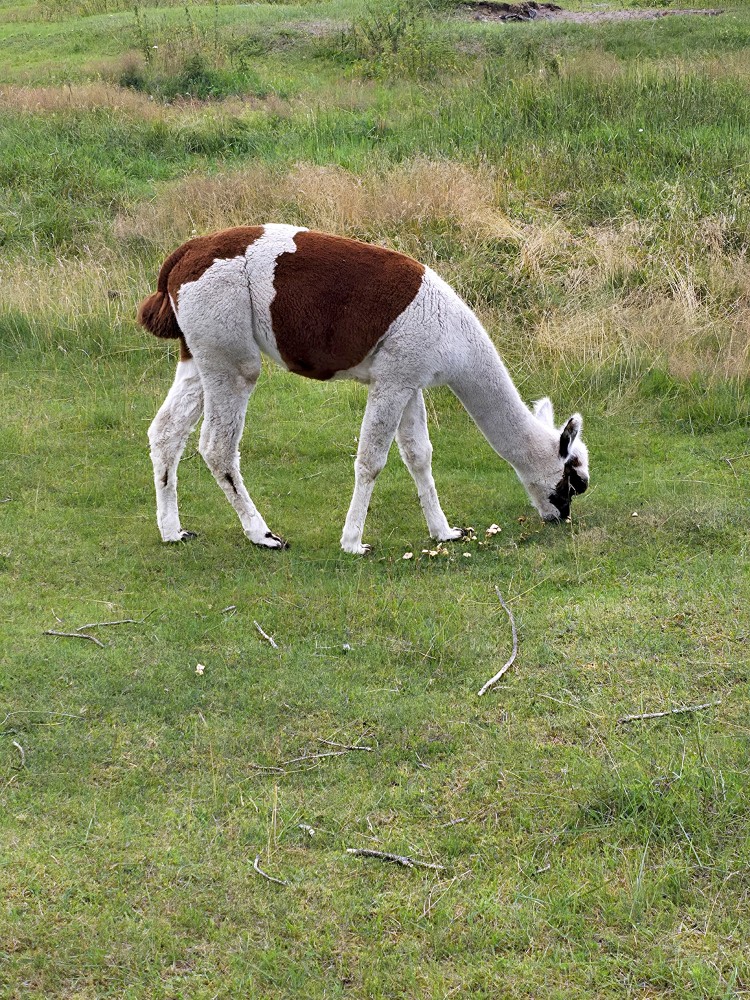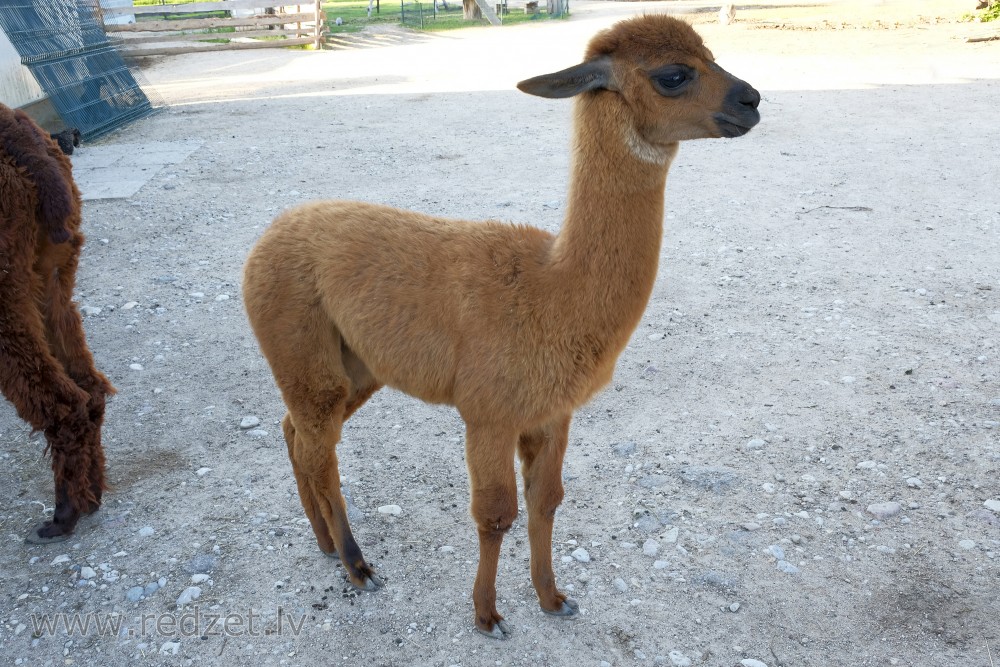Alpaca (Vicugna pacos)
The alpaca (Vicugna pacos) is a species of South American camelid. It is similar to, and often confused with, the llama. However, alpacas are often noticeably smaller than llamas. The two animals are closely related and can successfully cross-breed. Alpacas and llamas are also closely related to the vicuña, which is believed to be the alpaca's wild ancestor, and to the guanaco. There are two breeds of alpaca: the Suri alpaca and the Huacaya alpaca.
Alpacas are kept in herds that graze on the level heights of the Andes of Southern Peru, Western Bolivia, Ecuador, and Northern Chile at an altitude of 3,500 m (11,500 ft) to 5,000 m (16,000 ft) above sea level. Alpacas are considerably smaller than llamas, and unlike llamas, they were not bred to be working animals but were bred specifically for their fiber. Alpaca fiber is used for making knitted and woven items, similar to sheep's wool. These items include blankets, sweaters, hats, gloves, scarves, a wide variety of textiles and ponchos in South America, and sweaters, socks, coats and bedding in other parts of the world. The fiber comes in more than 52 natural colors as classified in Peru, 12 as classified in Australia, and 16 as classified in the United States.
Alpacas communicate through body language. The most common is spitting when they are in distress, fearful, or mean to show dominance. Male alpacas are more aggressive than females, and tend to establish dominance of their herd group. In some cases, alpha males will immobilize the head and neck of a weaker or challenging male in order to show their strength and dominance.
In the textile industry, "alpaca" primarily refers to the hair of Peruvian alpacas, but more broadly it refers to a style of fabric originally made from alpaca hair, such as mohair, Icelandic sheep wool, or even high-quality wool from other breeds of sheep. In trade, distinctions are made between alpacas and the several styles of mohair and luster.
An adult alpaca generally is between 81–99 centimetres (32–39 in) in height at the shoulders (withers). They usually weigh between 48–84 kilograms (106–185 lb).
| Alpaca | |
| Kingdom: | Animalia |
| Phylum: | Chordata |
| Class: | Mammalia |
| Order: | Artiodactyla |
| Family: | Camelidae |
| Genus: | Vicugna |
| Species: | V. pacos |
Background
Alpacas have been domesticated for thousands of years. The Moche people of Northern Peru often used alpaca images in their art. There are no known wild alpacas, and its closest living relative, the vicuña (also native to South America), is believed to be the wild ancestor of the alpaca.
The family Camelidae first appeared in Americas 40–45 million years ago, during the Eocene period, from the common ancestor, Protylopus. The descendants divided into Camelini and Lamini tribes, taking different migratory patterns to Asia and South America, respectively. Although the camelids became extinct in North America around 3 million years ago, in the South flourished with the tribes we see today. It was not until 2–5 million years ago, during the Pliocene that the genus Hemiauchenia of the tribe Lamini split into Palaeolama and Lama, the latter would then split again into Lama and Vicugna upon migrating down to South America.
Remains of vicuña and guanaco have been found throughout Peru for around 12,000 years. Their domesticated counterparts, the llama and alpacas have been found mummified in the Moquegua valley in the south of Peru dating back 900 to 1000 years. Mummies found in this region shows two breeds of alpacas. More precise analysis of bone and teeth of these mummies has demonstrated that alpacas were domesticated from the Vicugna vicugna. Other research, considering the behavioral and morphological characteristics of alpacas and their wild counterparts, seems to indicate that alpacas could find their origins in Lama guanicoe as well as Vicugna vicugna, or even a hybrid of both.
Genetic analysis shows a different picture of the origins of the alpaca. Analysis of mitochondrial DNA shows that most alpacas have guanaco mtDNA, and many also have vicuña mtDNA. But microsatellite data shows that alpaca DNA is much more similar to vicuña DNA than to guanaco DNA. This suggests that alpacas are descendants of the Vicugna vicugna, not of the Lama guanicoe. The discrepancy with mtDNA seems to be a result of the fact that mtDNA is only transmitted by the mother, and recent husbandry practices have caused hybridization between llamas (which primarily carry guanaco DNA) and alpacas. To the extent that many of today's domestic alpacas are the result of male alpacas bred to female llamas, this would explain the mtDNA consistent with guanacos. This situation has led to attempts to reclassify the alpaca as Vicugna pacos.
Breeds
Alpacas come in two breeds, Suri and Huacaya, based on its fiber rather than conventional or European classifications.
Huacaya alpacas are the most commonly found, about 90% of the population. The Huacaya alpaca is thought to be originated in post-colonial Peru. This is due to their thicker fleece which makes them more suited to survive in the higher altitudes of the Andes after being pushed into the highlands of Peru when conquistadors arrived.
Suri alpacas represent a smaller portion of the total alpaca population, around 10%. They are thought to have been more prevalent in pre-Columbian Peru since they could be kept at a lower altitude where a thicker fleece was not needed for extenuating weather conditions.
Behavior
Alpacas are social herd animals that live in family groups, consisting of a territorial alpha male, females, and their young ones. Alpacas warn the herd about intruders by making sharp, noisy inhalations that sound like a high-pitched bray. The herd may attack smaller predators with their front feet and can spit and kick. Their aggression towards members of the canid family (coyotes, foxes, dogs etc.) is exploited when alpacas are used as guard llamas for guarding sheep.
Alpacas can sometimes be aggressive, but they can also be very gentle, intelligent, and extremely observant. For the most part, alpacas are very quiet, but male alpacas are more energetic when they get involved in fighting with other alpacas. When they prey, they are cautious but also nervous when they feel any type of threat. They can feel threatened when a person or another alpaca comes up from behind them.
Alpacas set their own boundaries of "personal space" within their families and groups. They make a hierarchy in some sense, and each alpaca is aware of the dominant animals in each group. Body language is the key to their communication. It helps to maintain their order. One example of their body communication includes a pose named broadside, where their ears are pulled back and they stand sideways. This pose is used when male alpacas are defending their territory.
When they are young, they tend to follow larger objects and to sit near or under them. An example of this is a baby alpaca with its mother. This can also apply when an alpaca passes by an older alpaca.
Training
Alpacas are often very trainable and will usually respond to reward; most commonly in the form of food. They are able to be pat without getting abrogated although this is usually only when the animal is not being patted around the head or neck. Alpacas are usually quite easy to herd; even in large groups. Although when being herded, it is recommended that the handler approaches the animals slowly and quietly, not doing this can result in danger for both the animals and the handler.
Spitting
Not all alpacas spit, but all are capable of doing so. "Spit" is somewhat euphemistic; occasionally the projectile contains only air and a little saliva, although alpacas commonly bring up acidic stomach contents (generally a green, grassy mix) and project it onto their chosen targets. Spitting is mostly reserved for other alpacas, but an alpaca will also occasionally spit at a human.
Spitting can result in what is called "sour mouth". Sour mouth is characterized by a loose-hanging lower lip and a gaping mouth.
Alpacas can spit for several reasons. A female alpaca spits when she's not interested in a male alpaca, typically when she thinks she's already impregnated. Both sexes of alpaca keep others away from their food, or anything they have their eyes on. Most give a slight warning before spitting by blowing air out and raising their heads, giving their ears a "pinned" appearance.
Alpacas can spit up to ten feet if they need to. For example, if another animal does not back off, the alpaca will throw up its stomach contents, resulting in a lot of spit.
Some signs of stress which can lead to their spitting habits include: humming, a wrinkle under their eye, drooling, rapid breathing, and stomping their feet. When alpacas show any sign of interest or alertness, they tend to sniff their surroundings, watch closely, or stand quietly in place and stare.
When it comes to reproduction, they spit because it is a response triggered by the progesterone levels being increased, which is associated with ovulation.
Hygiene
Alpacas are generally very organized and neat. When they defecate they usually designate one place, even if they need to walk farther away. They use a communal dung pile. Their waste is collected and used as garden fertilizer or even natural fertilizer.
Another factor that goes into alpaca hygiene[citation needed] is their tooth care. When observing the teeth of an alpaca, it is a good way to tell if they have a healthy digestive system. Alpacas have their full set of adult teeth by the age of six. Male alpacas have 32 teeth and female alpacas have 30 teeth. Males have two extra teeth, called fighting teeth, but females only rarely have these. Alpacas have six lower incisors which help them bite off plants to chew. They do not have any upper incisors, but their mouths are lined up perfectly so that they have the ability to eat grass, hay, and plants.
There are warning signs to when an alpaca may have dental hygiene problems. One way to tell is if they take a while to chew their grass or hay or when they are eating, they continue to spill all their food and not keep it in their mouths. Another sign can be the poor body condition and if their cheeks are pushed in.
Alpacas use a communal dung pile, where they do not graze. This behaviour tends to limit the spread of internal parasites. Generally, males have much tidier, and fewer dung piles than females, which tend to stand in a line and all go at once. One female approaches the dung pile and begins to urinate and/or defecate, and the rest of the herd often follows.
Because of their preference for using a dung pile, some alpacas have been successfully house-trained.
Sounds
- Humming: When alpacas are born, the mother and its child hum constantly. They also hum as a sign of distress, especially when they are separated from their herd. Alpacas may also hum if they are curious, happy, worried or cautious.
- Snorting: Alpacas snort when another alpaca is invading their space.
- Grumbling: Alpacas grumble to warn each other. For example, when one is invading another's personal space, it sounds like they are gurgling.
- Clucking: Similar to a hen's cluck, alpacas cluck when a mother is concerned for her cria. Male alpacas will cluck to signal friendly behavior.
- Screaming: Their screams are extremely deafening and loud. They will scream when they are not handled correctly or when they are being attacked by a potential enemy.
- Screeching: A bird-like cry, presumably intended to terrify the opponent. This sound is typically used by a male alpaca when they are in a fight over who will dominate. When a female screeches, it is more of a growl when they are angry.
Reproduction
Females are induced ovulators; the act of mating and the presence of semen causes them to ovulate. Females usually conceive after just one breeding, but occasionally do have trouble conceiving. Artificial insemination is technically difficult, expensive and not common, but it can be accomplished. Embryo transfer is more widespread.
A male is usually ready to mate for the first time between two and three years of age. It is not advisable to allow a young female to be bred until she is mature and has reached two-thirds of her mature weight. Over-breeding a young female before conception is possibly a common cause of uterine infections. As the age of maturation varies greatly between individuals, it is usually recommended that novice breeders wait until females are 18 months of age or older before initiating breeding.
Alpacas can breed at any time but it is more difficult to breed in the winter. Most breed during autumn or late spring. The most popular way to have alpacas mate is pen mating. Pen mating is when they move both the female and the desired male into a pen. Another way is paddock mating where one male alpaca is let loose in the paddock with several female alpacas.
The gestation period is, on an average, 11.5 months, and usually results in a single offspring, or cria. Twins are rare, occurring about once per 1000 deliveries. Cria are generally between 15 and 19 pounds, and are standing 30 to 90 minutes after birth. After a female gives birth, she is generally receptive to breeding again after about two weeks. Crias may be weaned through human intervention at about six months old and 60 pounds, but many breeders prefer to allow the female to decide when to wean her offspring; they can be weaned earlier or later depending on their size and emotional maturity.
The average lifespan of an alpaca is between 15–20 years, and the longest-lived alpaca on record is 27 years.
Habitat and lifestyle
Alpacas can be found native all over South America. They typically live in temperate conditions in the mountains with high altitudes.
They are easy to care for since they are not limited to a specific type of environment. Animals such as flamingos, condors, spectacled bears, mountain lions, coyotes, llamas, and sheep live near alpacas when they are in their natural habitat.
Population
Alpacas are native to Peru; it currently has the largest population of alpacas in the world. About half of the alpacas worldwide are in Peru. The population declined drastically after the Spanish Conquistadors invaded the Andes mountains in 1532, after which 98% of the animals were destroyed. The Spanish also brought with them diseases that were fatal to alpacas.
As a result of the invasion, alpacas were forced to move higher into the mountains and remained there permanently. Although alpacas had almost been wiped out completely, they were rediscovered sometime during the 19th century by Europeans. After finding uses for them, the animals became important to societies during the industrial revolution.
Today, alpacas can be found all over the world, only excluding the Antarctic.
en.wikipedia.org



